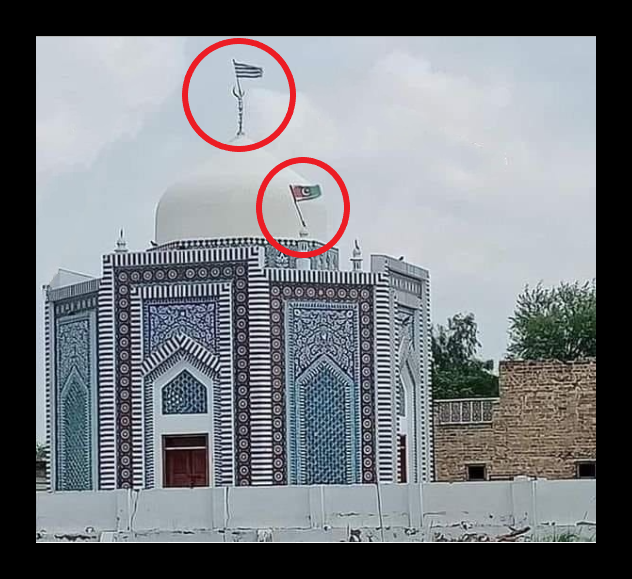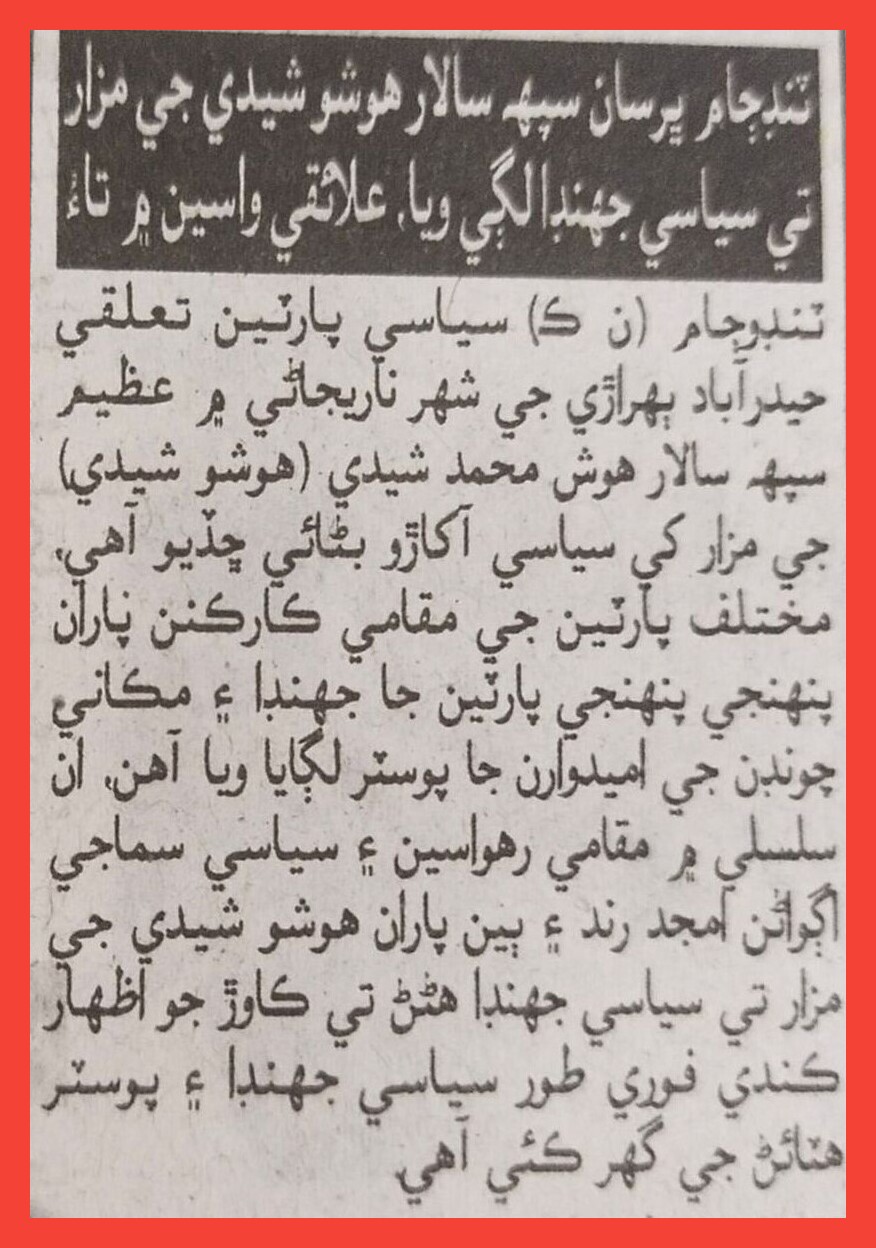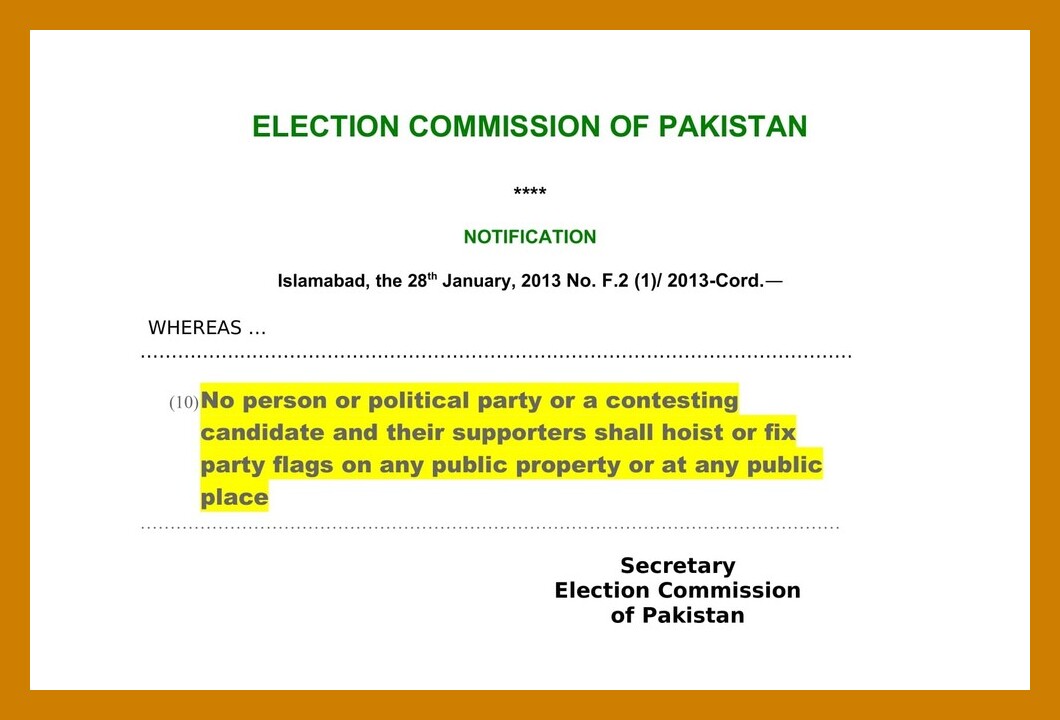
Sindh Government, leadership of the PPP and JUI are bound to show their constitutional responsibilities and respect for the ECP’s code of conduct.
‘I am afraid if the occupation and damage of heritage sites continued, then be assured very soon only books will support our claim that ‘Once Sindh was ancient and civilized’.
Zaffar Junejo
Since last week a photo was in circulation. Precisely, in social media terms – photo has become viral. It shows – hoisted flags of Pakistan Peoples’ Party and Jamiat Ulema-e-Islam over the monument of Hosh Muhammad Sheedi – a brave man of Sindh who fought fearlessly at the battleground of Miani, 1843.
I got that photo, when a Facebook friend tagged it to me. I immediately visited the Election Commission of Pakistan’s website, and searched its ‘Code of Conduct.’ It was issued on 28th January, 2013, with an outward number No. F.2 (1)/2013-Cordination. It reads: ‘No person or political party or a contesting candidate and their supporters shall hoist or fix party flags on any public property or at any public place (refer the notice’s serial number point 10). I read, but I was not quite clear about the definition of ‘Public Property’ term. I consulted Merriam Webster’s online dictionary. It mentions: ‘Public Property, something owned by the city, town, or state.’ (Note: most of the literature has interchangeable use of ‘Public Place’ and ‘Public Property’.)

I also referred an ordinary law dictionary. It revealed: ‘Public Property, a property owned by government and used by the general public, e.g. public parks and etc. & etc. It further reads: ‘It is owned by a government or a community, property owned by the government or an agency or division for the benefit of the citizens.’ Now, I was confident that subject to above definitions, Hosh Muhammad Sheedi’s Monument surely falls into the category of Public Property, and political parties are bound to abide by the Code of Conduct.
Afterwards, another idea came to my mind to check, how Indian election commission or related bodies have handled this attitudinal issue. I clicked various websites, with an understanding that we share lots of things to each other– history, archaeology, trade routes, ecological zones, borders, and even were subjects of the same Queen. I was surprised to note that in our neighborhood, District Collectors were bound to ensure implementation of the election’s code. Let me highlight, one of the collectors’ press conference. It was published in The Hindu (15th March, 2021) with a caption: ‘Party flags should not be hoisted in public places.’ I strongly believe that in our part of world Deputy Commissioners might have been responsible to implement ECP’s code or protect the historical monuments.
I vindicate that in the present case of disrespect to Hosh Muhammad Sheedi’s monument, Sindh Government’s officers may come with an apt reply: ‘None has pinpointed or complained.’ But, in present times of new communication technologies, concerned officers’ claim couldn’t be entertained. Not at all – because that photo is available almost at all digital platforms, and local people through print media had also complained. But all went in vain.

Let us see, how concerned quarters response, but my old notes remind me something different. Notes are based on my readings of Archaeological Surveys of India, Kawish and Dawn.
Let me summarize them- ‘Sindh’s archaeological sites are under threat due to natural ravages (rains, floods and other types of disasters) and peoples’ attitude – people excavate it in search of treasure, take bricks, and mud for the construction of houses, stampede it, and play games in preserved areas.’ Now, while I am writings this write-up, Abdul Wahid Arisar’s speech has compelled me to recall and reproduce it. In one of political gatherings, he said: ‘How long we would blame others, what about Kahu Jo Daro and Umerkot Fort’s destruction, both are being destroyed by our own people.’
I also remember MH Panhwar’s brief article, ‘Destruction of Protected Archaeology Sites in Sindh. ’ He has mentioned that destruction of the sites is continued for decades, and quoted some examples: ‘Thul Mir Rukan Stupa site is encroached, Kahu Jo Daro’s land is under cultivation, Depar Ghangro Daro’s land is in private hands.’ Likewise, he adds: ‘Dhamraho Daro’s considerable area is possessed by adjacent village, and Loham Jo Daro is possessed by a village and remaining portion is under the buildings and works of Dadu Sugar Mills.’ Similarly, according to him, ‘ancient Khudabad city’s remains are gone, and the area has been converted into agricultural lands.’
Now the question is how to stop vandalism? In Sindh, the situation has become difficult; there is poor response of political leaders and officials. The case in point is a cultural show at Mohenjo Daro. Although, conservationists approached UNESCO to stop the event, but the Sindh Government bowed before Bilawal Bhutto Zardari. Prior to the event, on 30th January 2014 ‘BBC Asia’ uploaded the story with a caption, ‘Pakistan’s Mohenjo Daro ruins ‘threatened by the festival.’ The Sindh Government bypassed international appeals and glued to its plan. So, in the case of Hosh Muhammad Sheedis Monument, I am not sure that culprits will be booked and tried. Someone may say that this vandalism has local context, but in all situations the Sindh Government, leadership of the PPP and JUI are bound to show their constitutional responsibilities and respect for the ECP’s code of conduct.
Really, I am afraid if the occupation and damage of heritage sites continued, then be assured very soon only books will support our claim that ‘Once Sindh was ancient and civilized’-Full Stop- nothing more nothing less. Thank you, dear for reading.
_________________
 Dr. Zaffar Junejo has a Ph.D. in History from the University of Malaya. His areas of interest are post-colonial history, social history and peasants’ history.
Dr. Zaffar Junejo has a Ph.D. in History from the University of Malaya. His areas of interest are post-colonial history, social history and peasants’ history.